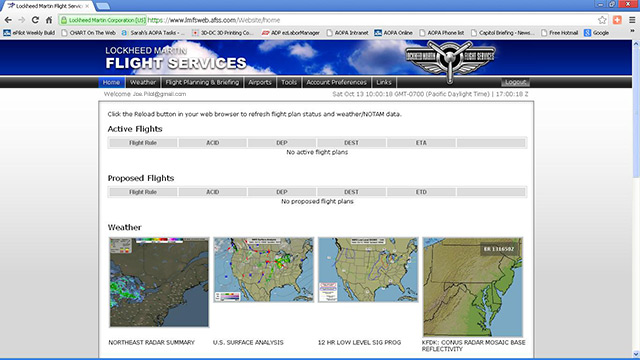
Pilots can personalize their home page with their preferred weather maps and metars, TAFs, and notams for selected airports.
You have your weather briefing, and everything looks good to go—for now. You have your eye on a convective sigmet to the west of your flight path, and TFRs have had a nasty habit of popping up on your swing state this campaign season. What if conditions change?
Lockheed Martin Flight Services announced a flight planning and briefing Web portal Oct. 12 that allows pilots to sign up for alerts of adverse conditions that crop up along their flight plan after they’ve obtained a briefing. Hundreds of attendees at AOPA Aviation Summit signed up for exclusive access to the website, where they could sign up for the alerts, before the tool rolls out to the public Nov. 5.
Adverse Condition Alerting Services (ACAS) provide alerts via email, text message, or satellite communications devices for TFRs, airmets, sigmets, convective sigmets, center weather advisories, severe weather advisories, airport and runway closures, and urgent pireps/aireps. The alerts, which advise the pilot to contact flight service, are flight-plan specific, start after a pilot has received a briefing, and expire, so pilots only receive notifications relevant to their time and route of flight. Pilots also can opt to receive reminders to close their flight plans. Pilots on IFR flight plans receive ACAS alerts up to 30 minutes before departure, when the plans are deleted from the flight services automation system and passed on to ATC.
Lockheed Director of Aviation Services Jim Derr said the Web portal offers a secure mass ingestion point for pilots to file a flight plan, get a weather briefing, and sign up for future services. Other online vendors that offer flight plan filing submit the information to flight service an hour before the scheduled flight, he said, which means Lockheed has no record of a plan when a pilot calls before then to change it. Pilots often don’t understand why their flight plan seemingly disappeared into the ether. When a pilot files through the Lockheed portal, the plan will immediately be accessible to Lockheed specialists.
“Once you file with us, it’s in our system,” he said.
Lockheed is providing the Web portal at no charge to the pilot or taxpayer, Derr said, and doesn’t intend it to supplant other vendors’ products. It offers pilots options on how they want to receive preflight information.
“The more information out there for pilots, the better,” Derr said. “The more information out there for pilots, the safer.”
Pilots set up an account and can personalize their home page to display metars, TAFs, and notams for up to three airports along with up to four weather graphics.
On the horizon: Smarter search and rescue
Flight tracking devices such as Spidertracks could alert flight service specialists—and kick off search and rescue efforts—immediately upon a lost signal or distress call through a system in development by Lockheed Martin.
Search and rescue efforts normally begin when an airplane is more than 30 minutes past its estimated time of arrival. With surveillance-enhanced search and rescue, expected to be operational in the spring, efforts could begin promptly after a signal stops broadcasting or the pilot pushes an emergency button on his or her satellite-based tracking device. Lockheed Martin is working with Spidertracks first, but Flight Services Chief Architect Mike Glasgow said the company plans to work with different vendors through a standardized interface.
Pilots with the tracking devices should be sure to place them in a location with a clear view to the sky. Glasgow acknowledged that during testing in cars, the transmission didn’t work if the driver moved the device from the dashboard to the seat.


